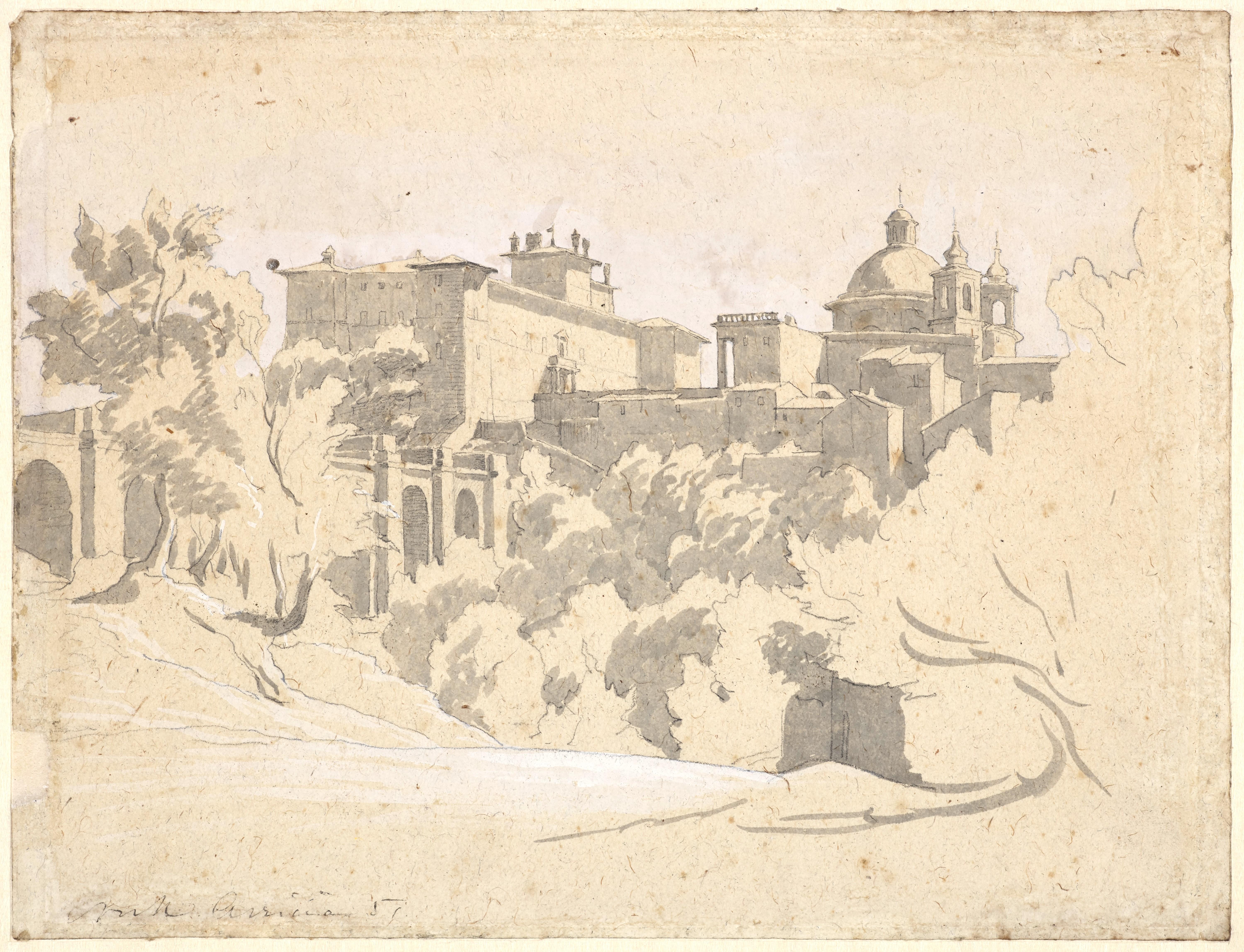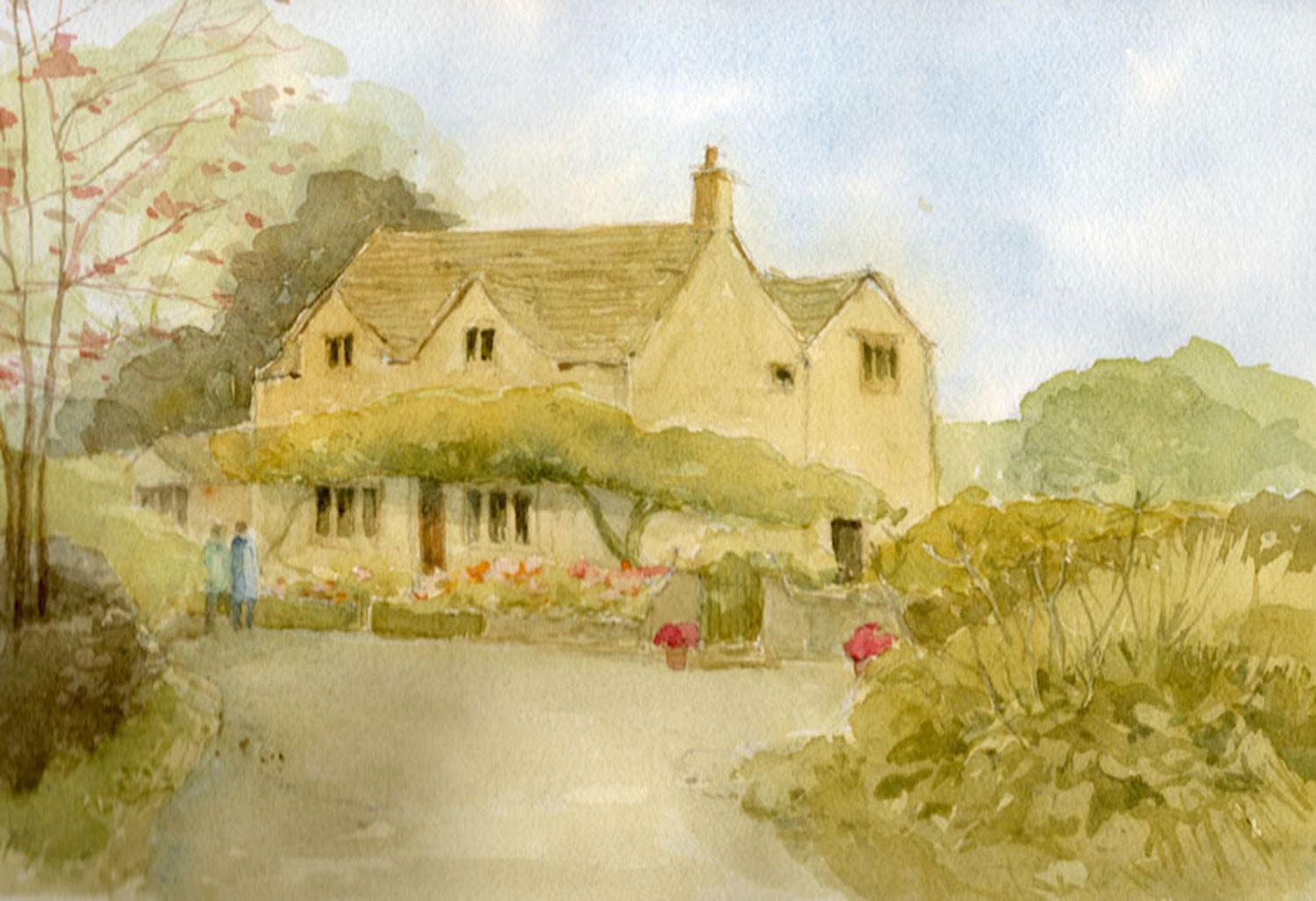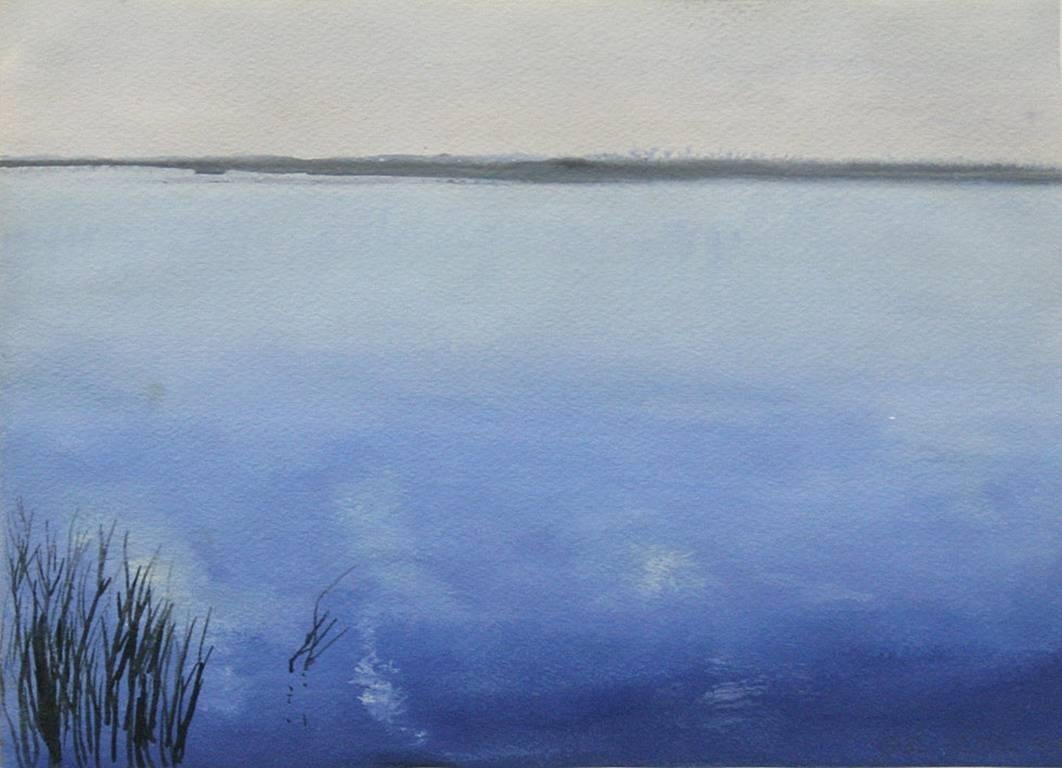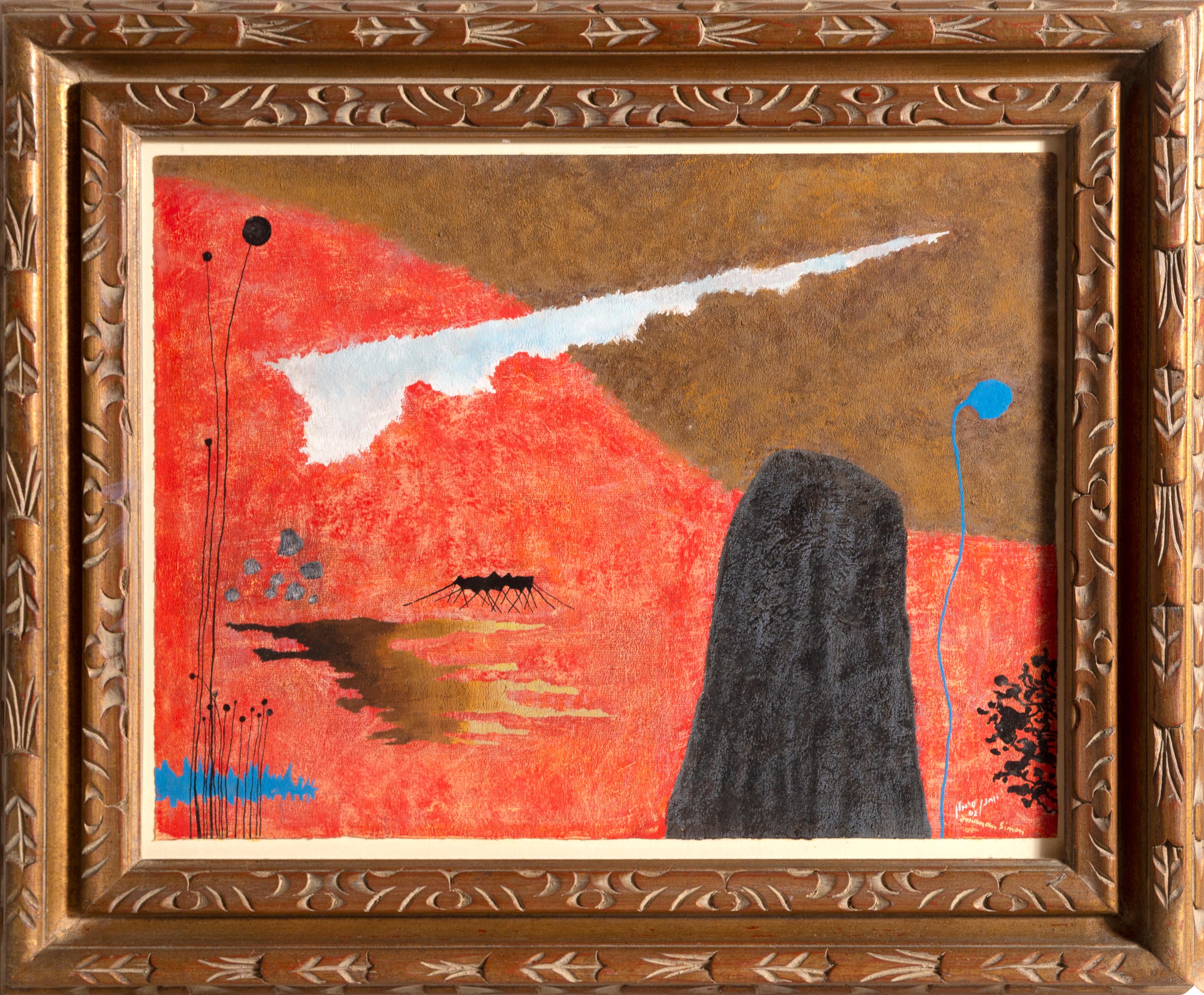Items Similar to View of the Ovo Castle in the Moonlight, a 19th century Neapolitan gouache
Want more images or videos?
Request additional images or videos from the seller
1 of 8
UnknownView of the Ovo Castle in the Moonlight, a 19th century Neapolitan gouache circa 1830
circa 1830
About the Item
Neapolitan gouaches appeared in the eighteenth century when tourism in the Naples area was developing: the discoveries of Herculaneum and Pompeii made this city a mandatory stop on the Grand Tour, the journey made by wealthy Europeans to complete their education.
Generally small in size for ease of transport and affordable in price, these gouaches were the ideal travel souvenir that these tourists of the early days were bringing back to capture the idyllic landscapes they had discovered during their journey and to share them with family and friends upon their return at home.
The Bay of Naples and the eruptions of Vesuvius are the favourite themes of these views. Here we have a view of the Ovo Castle, which was rebuilt on the island of Partenope, in the middle of the Bay of Naples and about a hundred metres from the shore by the Normans in the 12th century on antique ruins. Its name (Egg Castle in Italian) derives from a legend attributed to the poet Virgil: a sorcerer is said to have deposited a magic egg under the foundations of the castle which, if it disappeared, would lead to the ruin of the city.
The quayside, today’s Via Partenope, has always been lined with luxurious hotels, and one might think that this is one of the reasons why this view has been chosen as a souvenir for tourists. The execution of the painting, which is quite lively, the costumes of the characters at the water's edge, the romantic atmosphere on a full moon evening, clearly indicate that we are dealing with a gouache from the first half of the nineteenth century, a period which corresponds to the end of the production of these gouaches, which were soon to be supplanted by the development of photography.
We have chosen to frame this gouache in a French giltwood frame from the Restoration period, following the tradition that these travel souvenirs were framed by their owners after their return in a frame from their country, without any reference to the country where the gouache had been executed.
- Creation Year:circa 1830
- Dimensions:Height: 12.19 in (30.97 cm)Width: 14 in (35.56 cm)
- Medium:
- Movement & Style:
- Period:
- Condition:7 ½’’ x 9 5/8’’ (19 x 24.5 cm) - Framed 12 3/16’’x 14” (31 x 35.5 cm) French Gilded wood frame from the Restoration period (1815 - 1830).
- Gallery Location:PARIS, FR
- Reference Number:1stDibs: LU1568211773882
About the Seller
5.0
Vetted Seller
These experienced sellers undergo a comprehensive evaluation by our team of in-house experts.
Established in 2020
1stDibs seller since 2021
8 sales on 1stDibs
Typical response time: 1 hour
- ShippingRetrieving quote...Ships From: PARIS, France
- Return PolicyA return for this item may be initiated within 3 days of delivery.
More From This SellerView All
- View of Ariccia, a preparatory drawing by Achille Bénouville (1815 - 1891)Located in PARIS, FRThis very modern drawing presents a view of Ariccia, a small town 25 kilometres south-east of Rome. The Palazzo Chigi (in which the film-maker Luchino Visconti would film a large part of The Leopard a century later) and the adjoining church are seen from the bottom of the ravine that surrounds the town. This drawing is a moving testimony to the attraction of the city for artists of the Romantic period, who established in Ariccia a vivid artists' colony. 1. Achille Bénouville...Category
1850s Romantic Landscape Drawings and Watercolors
MaterialsInk, Gouache, Pencil
- Pavilion with waterfall, an ink wash attributed to Hubert Robert (1733 - 1808)By Hubert RobertLocated in PARIS, FRThis large wash drawing is a slightly enlarged version of a composition executed by Hubert Robert in 1761, at the end of his stay in Rome. This composition is a marvellous synthesis of the painter's art: the clatter of the waterfall, in a grandiose setting inspired by antiquity, is opposed to the intimacy of a genre scene, made up of a few peasant women performing some agricultural work. 1. The stay in Italy, an important founding stage in Hubert Robert's carrier Hubert Robert came from a privileged family of Lorraine origin, linked to the Choiseul-Stainville family, where his father was an intendant. The protection of this powerful aristocratic family enabled him to study classical art at the Collège de Navarre (between 1745 and 1751). After a first apprenticeship in the workshop of the sculptor Slodtz (1705 - 1764), he was invited by Etienne-François de Choiseul-Beaupré-Stainville (the future Duke of Choiseul, then Count of Stainville) to join him in Rome when the latter had just been appointed ambassador. Hubert Robert arrived in Rome on 4 November 1754, aged twenty-one, and remained there until 24 July 1765. Thanks to his patron, he obtained a place as a pensioneer at the Académie de France without having won the prestigious Prix de Rome. On his arrival in Rome, he frequented the studio of the painter Giovanni Paolo Panini (1691 - 1765), the inventor of the ruins painting, and also benefited from the proximity of Giovanni Battista Piranesi’s studio (1720 - 1778). During his eleven-year stay in Rome, Hubert Robert studied the great Italian masters and drew many of the great archaeological sites, multiplying the sketches which he would use throughout his career, becoming one of the masters of the "ruin landscape". Back in Paris in 1765, he was very successful. He was accepted and admitted to the Royal Academy of Painting and Sculpture on the same day, July 26th 1766, which was very unusual. He was appointed draughtsman of the king's gardens in 1784, then guard of the Royal Museum from 1784 to 1792. Arrested in 1793 and detained in the prisons of Sainte Pélagie and Saint-Lazare, he was released in 1794 after the fall of Robespierre and undertook a second trip to Italy. In 1800, Hubert Robert was appointed curator of the new Central Museum and died at his home in Paris in 1808. 2. Description of the artwork This composition, formerly called "La Cascade du Belvédère Pamphile" , is undoubtedly inspired by the water theatres of the Frascati villas. Hubert Robert presents a hemicycle of columns with rustic bossages at the foot of which is a cascade of water falls into a basin. The hemicycle is flanked by two high walls, pierced by window wells topped with antique masks...Category
1760s Old Masters Landscape Drawings and Watercolors
MaterialsInk, Watercolor
- Study for « Paysage de Fribourg » - 1943 a drawing by Balthus (1908 - 2001)By Balthus (Balthasar Klossowski de Rola)Located in PARIS, FRProvenance: Frédérique Tison, Château de Chassy (Burgundy-Franche Comté - France) Bibliography: J. Clair, V. Monnier Balthus, catalogue raisonné of the complete works, Gallimard, Pa...Category
1940s Modern Landscape Drawings and Watercolors
MaterialsPencil, Paper
- Landscape with Trees and a Fisherman walking, a drawing by Jan Van GoyenBy Jan Josefsz Van GoyenLocated in PARIS, FRNo Dutch draughtsman ever captured the atmosphere of the rural countryside of Holland with the same atmospheric and engaging simplicity that Van Goyen achieved in drawings such as this. Indeed, his landscapes were seminal in the development of the genre. The present sketch conveys a striking sense of movement within the natural landscape, conveyed by the deftly applied strokes of chalk, from which the artist’s hand can be sensed. The composition is characteristic of his work, with the low horizon affording significance to the broad sky and the soaring birds within. This feeling of windswept motion powerfully evokes the expansive Dutch farmland with which he was evidently preoccupied. 1. Jan van Goyen...Category
1650s Old Masters Landscape Drawings and Watercolors
MaterialsChalk, Ink, Laid Paper
- View of Piazza San Marco, a tempera signed by Giacomo Guardi (1764 - 1835)Located in PARIS, FRSigned and localized on the verso : "Vedute di parte dalla Piazza dif.a alla Loggetta e cam panil parte della Zecca ed in lontan Proc.e vechie e parte della chiesa punto preso vic...Category
Early 19th Century Old Masters Landscape Drawings and Watercolors
MaterialsTempera
- View of an Antique City, a wash landscape by Jan de Bisschop (1628 - 1671)Located in PARIS, FRThe attribution to Jan de Bisschop has been confirmed by the RKD with the following comment: "We base this attribution on the dark washes, the subject represented and the monogram". ...Category
17th Century Old Masters Landscape Drawings and Watercolors
MaterialsInk, Pen
You May Also Like
- Elizabeth Chalmers, Lady Cottage in Nottgrove, Cotswold Art, English PaintingLocated in Deddington, GBElizabeth Chalmers Lady Cottage in Nottgrove Watercolour on paper Size: H 21 x W 30cm Signed by the artist Please note that insitu images are purely an indication of how a piece may...Category
2010s Romantic Landscape Paintings
MaterialsWatercolor, Paper
- Edward Lear, Extensive Greek Italian Landscape, Antique Ruins, Campagna di RomaBy Edward LearLocated in Greven, DEMost accounts of the artistic achievements of Edward Lear (1812–1888) take as their starting point the notion that he is better known as the writer of nonsense verse than as a topographical draughtsman and painter. His art is then considered largely in isolation, as the extraordinary creation of a fascinatingly eccentric Victorian. However, Lear's art is outstanding. Although Lear suffered from epilepsy, asthma, poor eyesight, and chronic depression, he was an inveterate traveler and an indefatigable sketcher, documenting a lifetime of journeys throughout the Mediterranean and India. During his two-month tour to Athens, mainland Greece and the island of Euboea, Edward Lear made almost 150 landscape drawings and kept a diary of his experiences and impressions. Many years later, Lear’s travelling companion, Charles Church...Category
19th Century Romantic Landscape Drawings and Watercolors
MaterialsWatercolor
- Edward Lear, Extensive Greek or Roman Landscape, Temple, Ruins, British ArtBy Edward LearLocated in Greven, DEMost accounts of the artistic achievements of Edward Lear (1812–1888) take as their starting point the notion that he is better known as the writer of nonsense verse than as a topographical draughtsman and painter. His art is then considered largely in isolation, as the extraordinary creation of a fascinatingly eccentric Victorian. However, Lear's art is outstanding. Although Lear suffered from epilepsy, asthma, poor eyesight, and chronic depression, he was an inveterate traveler and an indefatigable sketcher, documenting a lifetime of journeys throughout the Mediterranean and India. During his two-month tour to Athens, mainland Greece and the island of Euboea, Edward Lear made almost 150 landscape drawings and kept a diary of his experiences and impressions. Many years later, Lear’s travelling companion, Charles Church...Category
19th Century Romantic Landscape Paintings
MaterialsWatercolor
- Cove, Moriches BayBy John ButtonLocated in New York, NYGouache on paper This artwork is offered by ClampArt, located in New York City Born in California, John Button (1929-1982) was educated at University of California, Berkeley. After...Category
1970s Realist Landscape Paintings
MaterialsPaper, Gouache
- Israeli Landscape, Gouache Painting by Yohanan Simon 1962By Yohanan SimonLocated in Long Island City, NYArtist: Yohanan Simon (1905-1976) Title: Landscape Medium: Gouache on paper laid to card Date: 1962 Signature: Signed and dated in Hebrew Paper Size: 16.75 x 21 inches Frame Size: 24...Category
1960s Modern Landscape Paintings
MaterialsLaid Paper, Gouache
- Original 70's Hand Painted Textile Design Gouache Green Shades on White PaperLocated in ALCOY/ALCOI, ESWe offer a small number of these original illustration designs by this design studio based in Alcoy (Spain), which could pair well or make group sets if buyers so desired. Designed t...Category
1970s Modern Landscape Drawings and Watercolors
MaterialsPaper, Gouache
Recently Viewed
View AllMore Ways To Browse
French Giltwood Frame
Pompeii Drawings
Castle Drawing
Italian Gouache
Italy Gouache
French Castle Painting
Painting Of A French Castle
View Of The Moon
19th Century Gouache
19th Century European Watercolor
Nineteenth Century Drawings
View Naples
View Of Naples
Antique Framed Watercolor Landscapes
19th Century Painting Castle
19th Century Painting Of Castle
European Souvenirs
Antique Neapolitan



